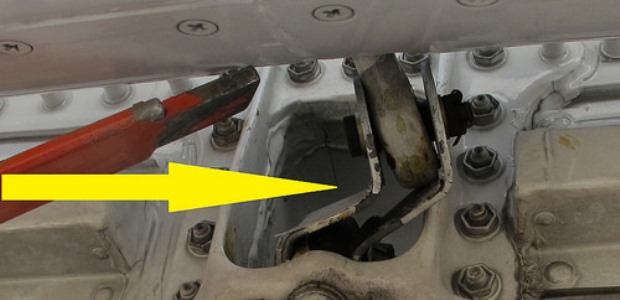
NTSB Provides Update on Rejected Landing in Michigan
The investigative update shows damaged linkage to the Boeing MD-83's right elevator was found.
The National Transportation Safety Board recently posted an investigative update about the March 8, 2017, rejected takeoff incident at Willow Run Airport in Ypsilanti, Mich. All 109 passengers and seven crew members evacuated Ameristar Air Cargo Inc. flight 9363 via escape slides after the Boeing MD-83 came to rest about 1,000 feet past the end of runway 23L, with one passenger suffering a minor injury during the evacuation.
NTSB cautions that the update doesn't provide a probable cause for the accident and does not contain analysis of information collected in its ongoing investigation, but it does describe and include a photo of a damaged linking to the airplane's right elevator, which did not move during the takeoff roll.
Parties to the investigation include the FAA, Boeing, and Ameristar Air Cargo, Inc. Two pilots were in the cockpit, both with airline transport pilot certificates with DC-9-series type ratings (this rating includes the MD-83), and the pilot-in-command, who was the Ameristar chief pilot, was in the right seat and was providing differences training to the captain, who was in the left seat and was the pilot flying the aircraft. The chief pilot had 9,660 total flight hours with 2,462 hours in DC 9 series airplanes. The captain (flying pilot) had 15,518 total flight hours with 8,495 hours in DC 9 series aircraft.
According to the update, investigators found the movement of the control column in the cockpit appeared normal: "the control columns were free to move, and the elevator control tabs moved as commanded. However, when investigators tried to move the elevator surfaces by hand, the left elevator moved normally, but the right elevator was jammed in a trailing edge-down position (airplane nose down). Upon further inspection, the right elevator geared tab inboard pushrod linkage was found damaged which restricted movement of the right elevator surface but allowed movement of the control tab. After the damaged components were removed, the elevator could be moved by hand," it says.
Flight data recorder data indicate during the taxi and take-off roll, the left elevator moved normally but the right elevator did not move. "During takeoff roll, the left elevator began a large airplane nose-up movement (consistent with rotation) at an airspeed of about 152 knots and continued for five seconds to about 166 knots. There was no change in the airplane pitch attitude during this time. The airplane data then are consistent with the takeoff being rejected. The maximum recorded airspeed was about 173 knots," it says. "Review of previous flight data showed normal movement of both the left and right elevator surfaces. The airplane flew to Ypsilanti two days before the accident."
Crew members said all slides except for the forward right door deployed correctly. That slide was removed from the airplane and will be examined by investigators.